The Ghosts of Soviets Past: Unearthing the Memory of Occupation in Estonia
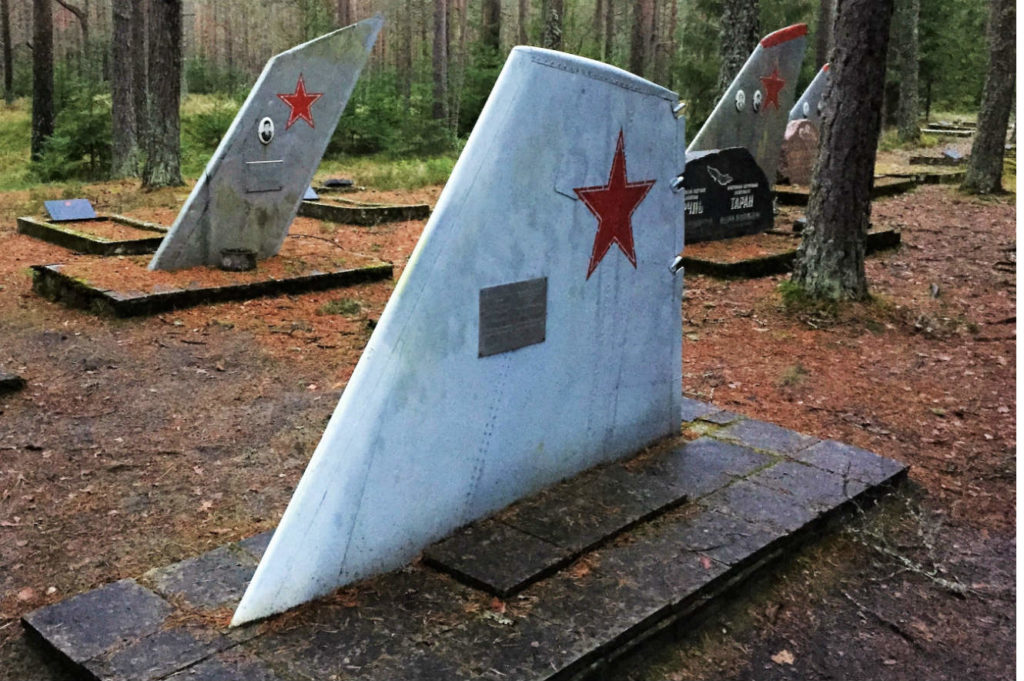
Editor’s note: In December 2015, two Army intelligence officers set out on a trip to explore the mysterious remnants of the Soviet Union in the Baltic States. This article is the third in a series detailing their journey (Read parts one and two at War on the Rocks).
“Hello, it’s me. I was wondering if after all these years you’d like to meet.”
The opening lines from Adele’s hit song suddenly came on the car radio after a long stretch of Slavic folk music. It was minutes before midnight, and a detour along our northbound route through the Eastern Baltics had led us straight toward a Russian border crossing. Slightly delirious from hours of driving, we saw an opportunity for amusement and began to sing along to the eerily timed lyrics, attempting to outdo each other with impressions of Vladimir Vladimirovich Putin. The rows of stadium lights leading to the crossing cast an uneasy glow across the otherwise dark Estonian countryside. Briefly dismounting for an impromptu photo-op, we continued on to the next chapter of our next Baltic journey: Narva, a city transformed entirely by the Soviet period.
At the easternmost point of Estonia lies its third-largest city, wedged between the Gulf of Finland and Estonia’s southern lake districts. Holding a strategic position, Narva’s past has been influenced by a multitude of peoples and empires: Danes, Swedes, Germans, Russians, and Estonians. During the 20th century, Narva changed hands several times: attaching itself to the fledgling Estonian Republic via a referendum in 1917, occupied twice by the Red Army, and contested heavily by both Nazi Germany and the Soviets during World War II. Intense fighting in 1944 led to the destruction of 98 percent of the city and a significant shift in its ethnic composition. Following the German army’s defeat at Narva, many ethnic Estonian residents were prohibited from returning by Soviet authorities. Today, a vast majority of Narva’s population (82 percent in 2013) remains ethnically Russian, and over a third are Russian citizens. The charming baroque architecture, having been erased by Nazi and Soviet ordnance, has long since been replaced by a skyline of block apartments — the human storage units of the Soviet proletariat.
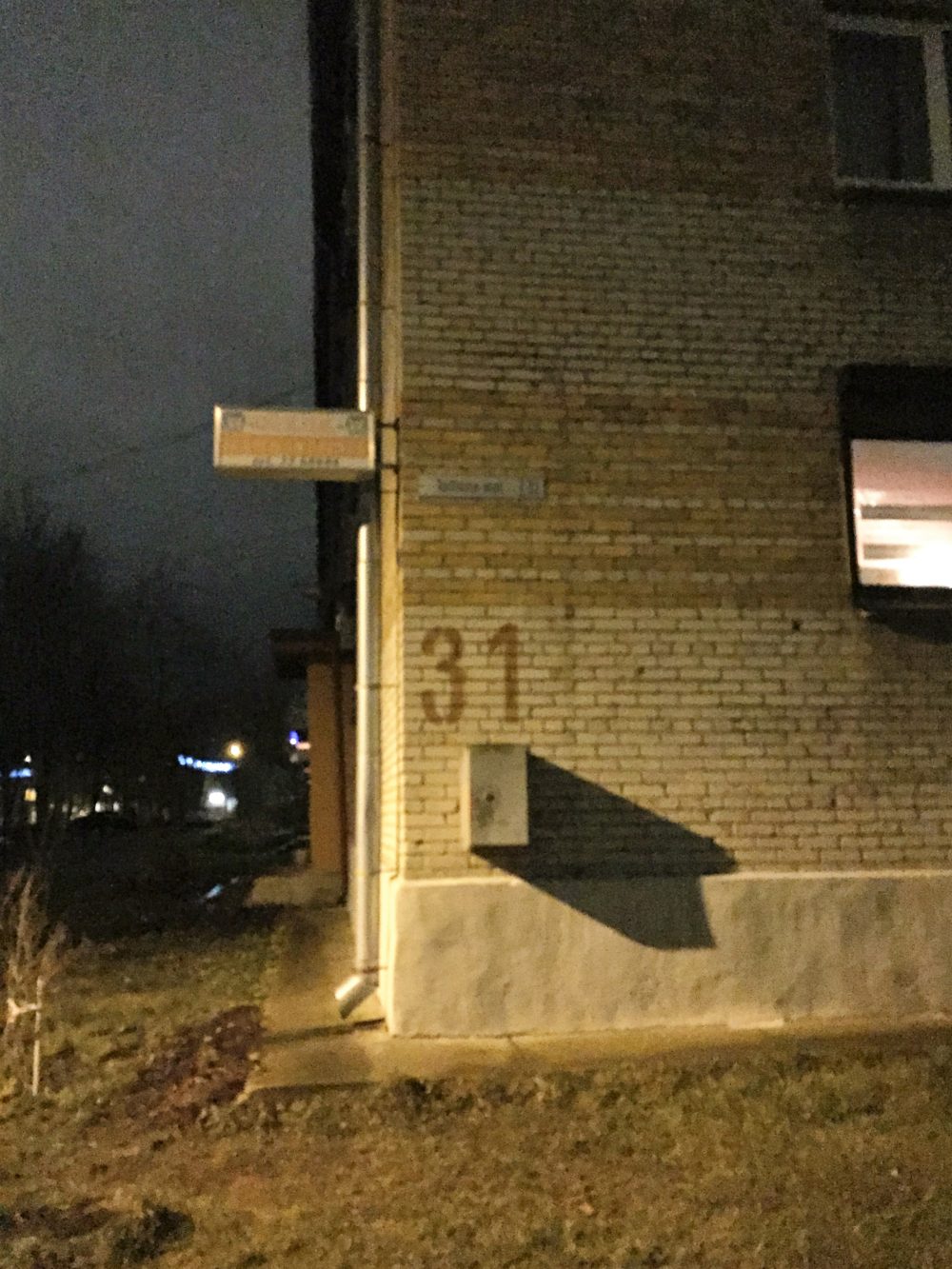
Venturing outside of Airbnb coverage, our accommodations in Narva consisted of a two-bedroom apartment in one of the dozens of Soviet-era walkups near the city center that we booked through a local site with atrocious English translations. Our GPS led us to a row of concrete apartment buildings with stencil-painted numbers and laundry hanging by wires between balconies. Through broken English and hand gestures, the friendly ethnic Russian proprietors gave us the grand tour. The interior was clean and simply furnished in a distinctly Russian style. Gold lamps and floral pink wallpaper radiated as the corner TV blared with one of Putin’s recent speeches.
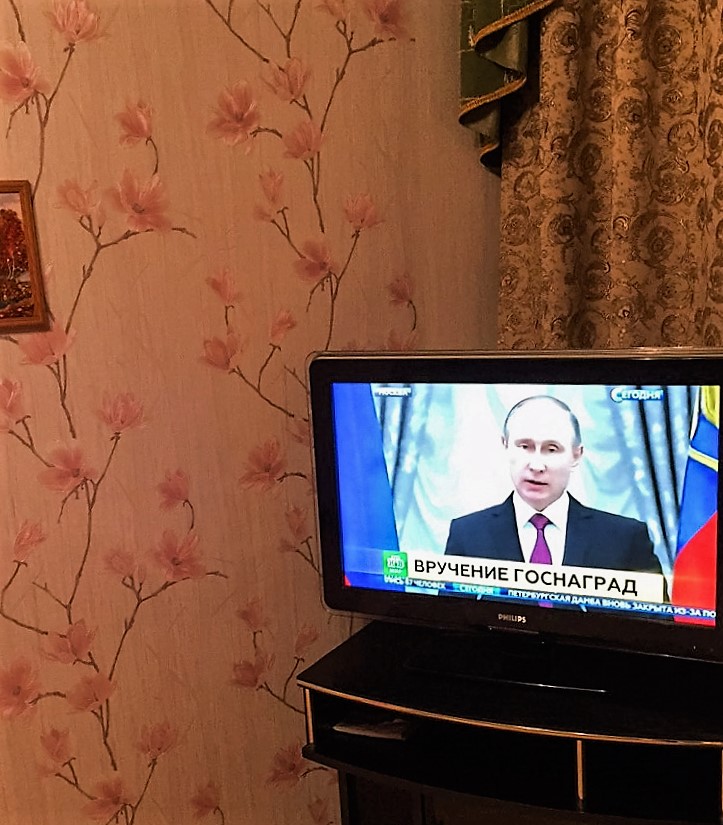
A globe lamp in one of the bedrooms still showed the Soviet Union. We settled into the rigid mattresses to rest before exploring the city fortifications in the morning.
Hermann Castle, Narva’s iconic medieval fortress, consists of a large, Germanic-style keep, with a whitewashed, timber-topped tower rising from gray walls. Like the majority of Old Narva, Hermann Castle’s tower suffered catastrophic damage from bitter fighting between the Soviets and Nazis during World War II. The current structure is a replica faithfully recreated in the 1970s. Today, a history museum is housed on the multiple levels of the tower, showcasing how Narva looked before the devastation of war. The ramparts of Hermann Castle descend to the banks of the Narva River, a sliver of estuary dividing Estonia from Russia, where the distance narrows to about 300 meters and a multi-lane bridge connects the two countries. Cars and people transit the bridge with the same casualness as New Jerseyans crossing the George Washington Bridge into New York City.
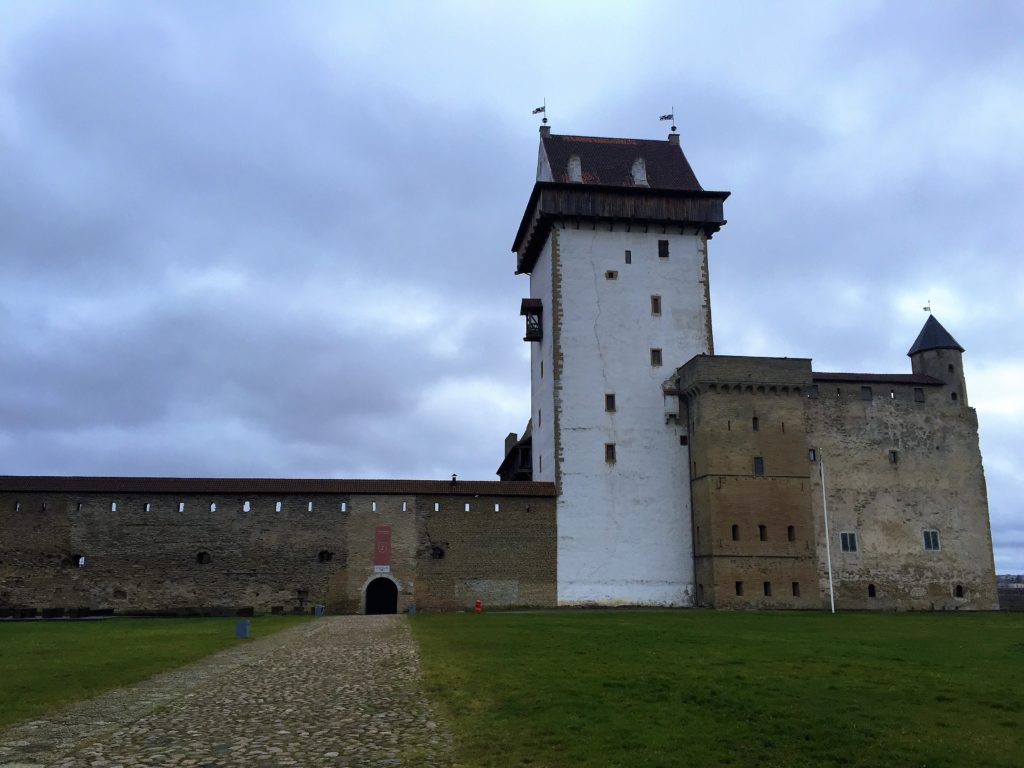
But beyond the business as usual, the quiet confrontation between Estonia and Russia is captured in the two looming castles on either side of the Narva River. Jutting westward are the slate ramparts of Ivangorod Fortress, built in the late 15th century to fend off Livonian Knights just across the waters. Ivangorod Fortress changed hands many times and was, at one time, used as a prisoner of war camp by Nazi Germany. Like two medieval knights preparing for a duel, the two castles stand ready to square off, shields up to brace for the first strike in a tense but otherwise bloodless standoff. Today, the opposing walls stand silent, with the Russian tricolor flag standing sentry at an otherwise vacant turret. For the sake of retaining our security clearances, this is the closest we’ll get to Russia today.
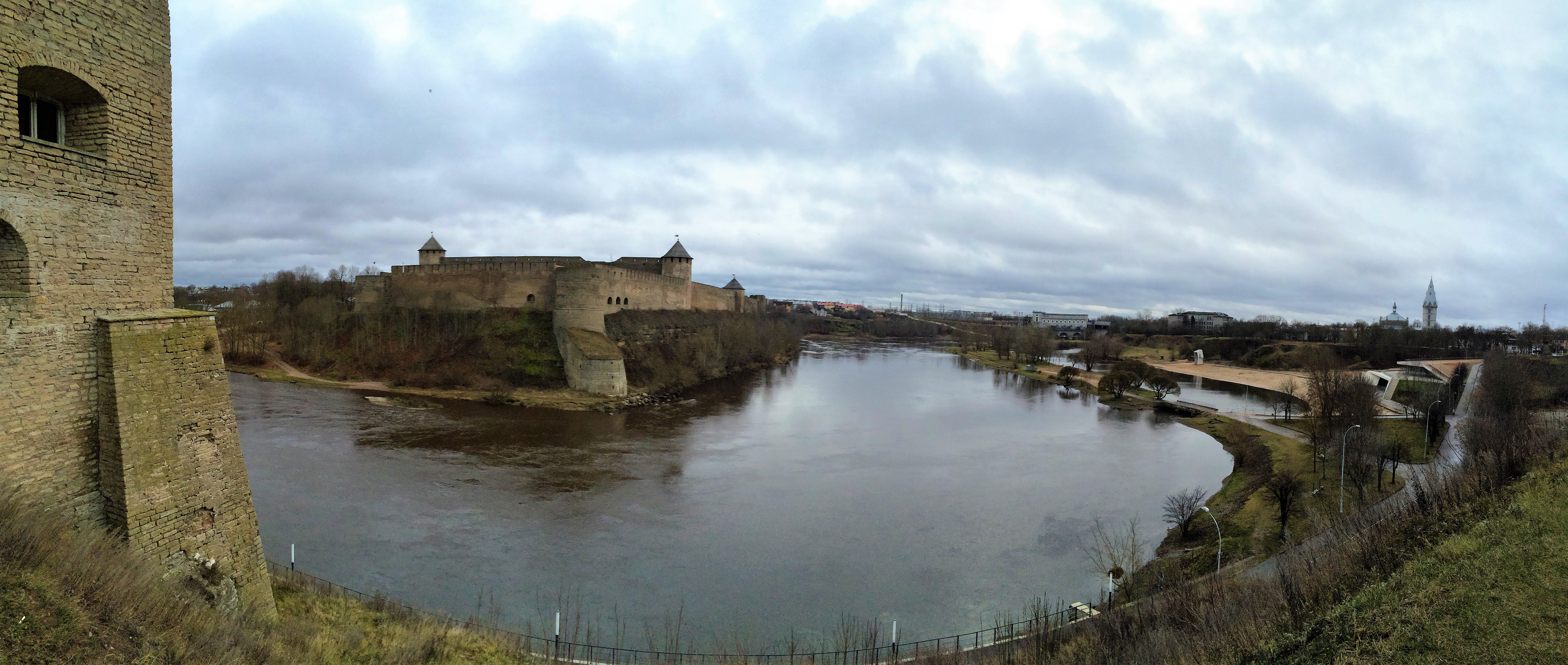
Tucked into a corner of Hermann Castle’s large courtyard is a 10-foot-tall statue of Lenin, standing defiantly with his right arm outstretched as if grasping toward the Motherland. Once displayed in a busy city square, the statue of Lenin was moved to a more discreet location two years after Estonia’s referendum for independence in 1991. Surrounded by a handful of angry ethnic Russian pensioners and war veterans, a construction crane unceremoniously hoisted Lenin from his place of prestige in the city center and transported him to the castle grounds. In a gesture of respect to the gathered protesters, the mayor of Narva personally ensured that the crane’s cable was not wrapped around the statue’s neck. In a country that strives to recreate its identity for the future, Narva’s outlying demographics cause it be an agent for immortalizing Estonia’s Soviet past.
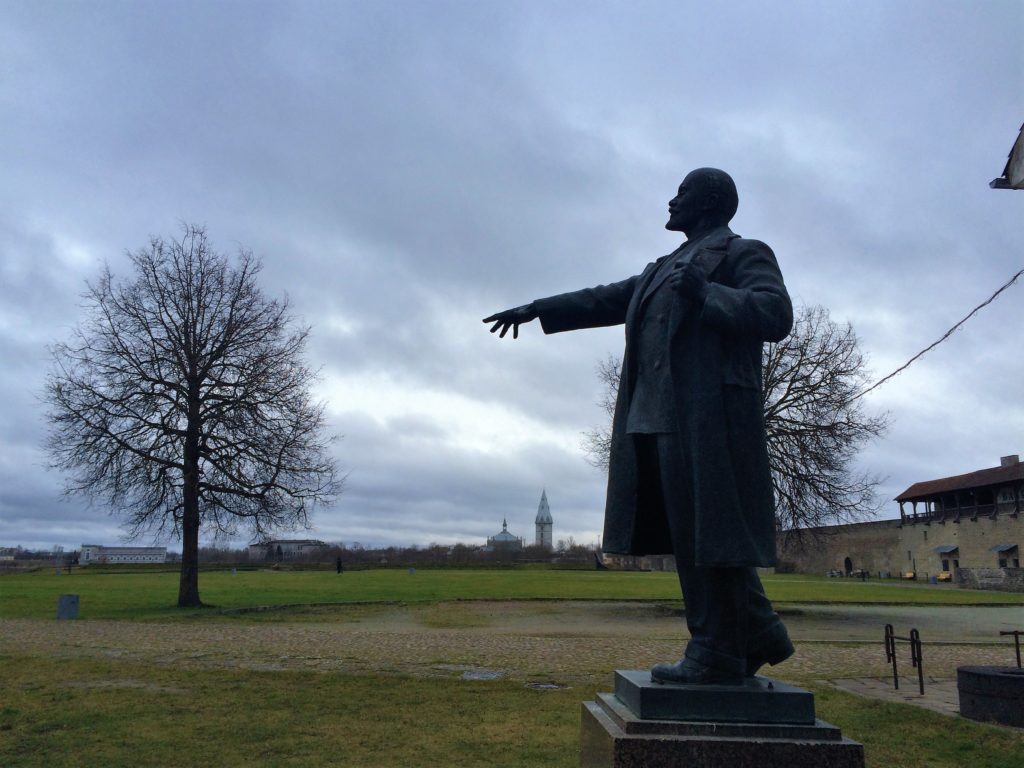
After bidding Lenin adieu, we drove down a road adjacent to the Narva River, hoping to catch a glimpse of the last remaining T-34 tank on public display in Estonia. A Russian police boat skimmed across the water, matching our speed, seemingly shadowing our car until the road turned inland.
The tank itself sits on a stone plinth a few dozen feet from the Narva River banks. Developed to replace the Soviet Union’s highly mobile but poorly armored BT-7, the T-34 provided a combination of improved sloped armor, superior speed and devastating firepower that could stand toe-to-toe against German panzers. As the new the mainstay of Soviet armored divisions, the T-34 was so successful that even the enemy praised its design. One German field marshal conceded that it was “the finest tank in the world.” Despite this legendary claim, the biggest contribution to the T-34’s success may have been its mass production, with over 50,000 in service by 1945. A simple inscription marks the tank’s significant location:
On 25–26 June 1944 the Leningrad front advanced into this region of the Narva River, broke through the fascist German defense and liberated the city of Narva.
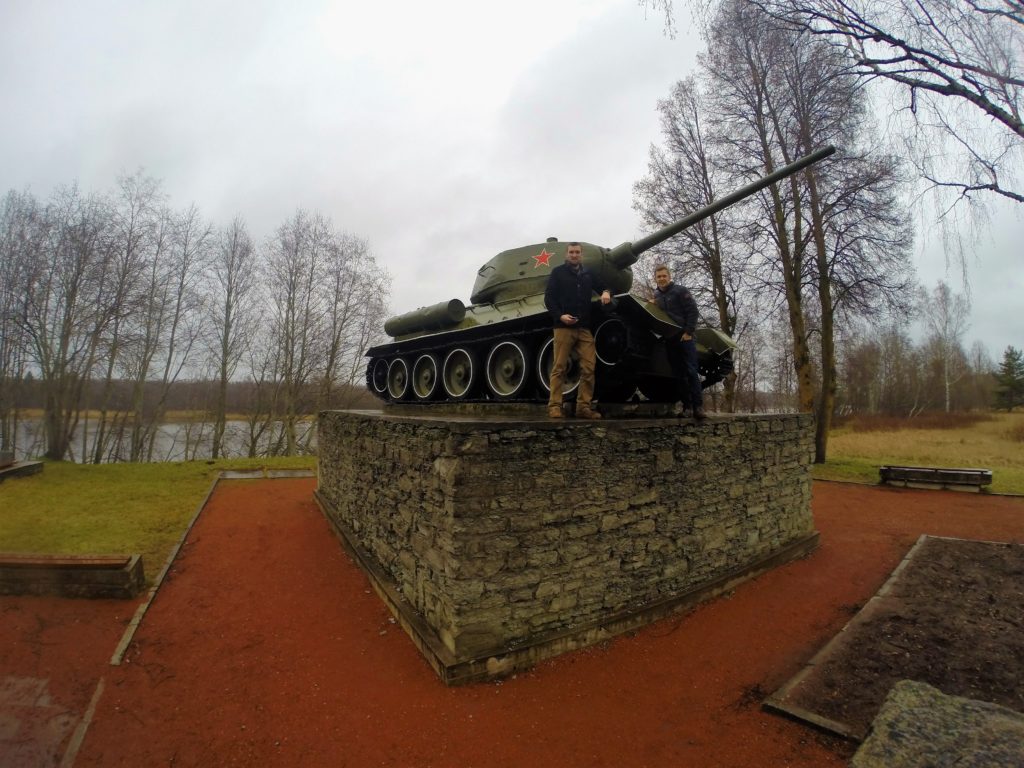
The breakthrough at the site of the T-34 monument marked a major turning point in the grueling six-month campaign the Soviets mounted to regain control of the Narva Isthmus from German occupation. Stalin had envisioned the Narva campaign as a relatively quick recovery of Estonia, with the potential to use its western shores as a springboard for attacks against Finland and East Prussia (now modern-day Poland, Lithuania and the Russian-controlled Kaliningrad Oblast). But the city of Narva was a hard-won prize, with an estimated 100,000 fatalities on the Soviet side alone.
Unlike many other Soviet-era monuments in the Baltic states, this tank remains publicly displayed and commemorated, devoid of the graffiti, vandalism, and neglect. A handful of red carnations appeared freshly placed by the monument, held together by the orange and black ribbon of St. George made infamous during the 2014 occupation of Crimea. An older gentleman admiring the tank while we were there conveyed to us in broken English that the tank remained a popular location for wedding photos. It was clear the monument’s meaning varied based on the perspective of the beholder. To an ethnic Russian resident of Narva, it symbolizes liberation and the strength of the Red Army as a force for good. To an ethnic Estonian, the Soviet tank’s frozen advance into a now-independent and NATO-aligned Estonia draws unsettling parallels with the increased Russian military buildup on the other side of the river.
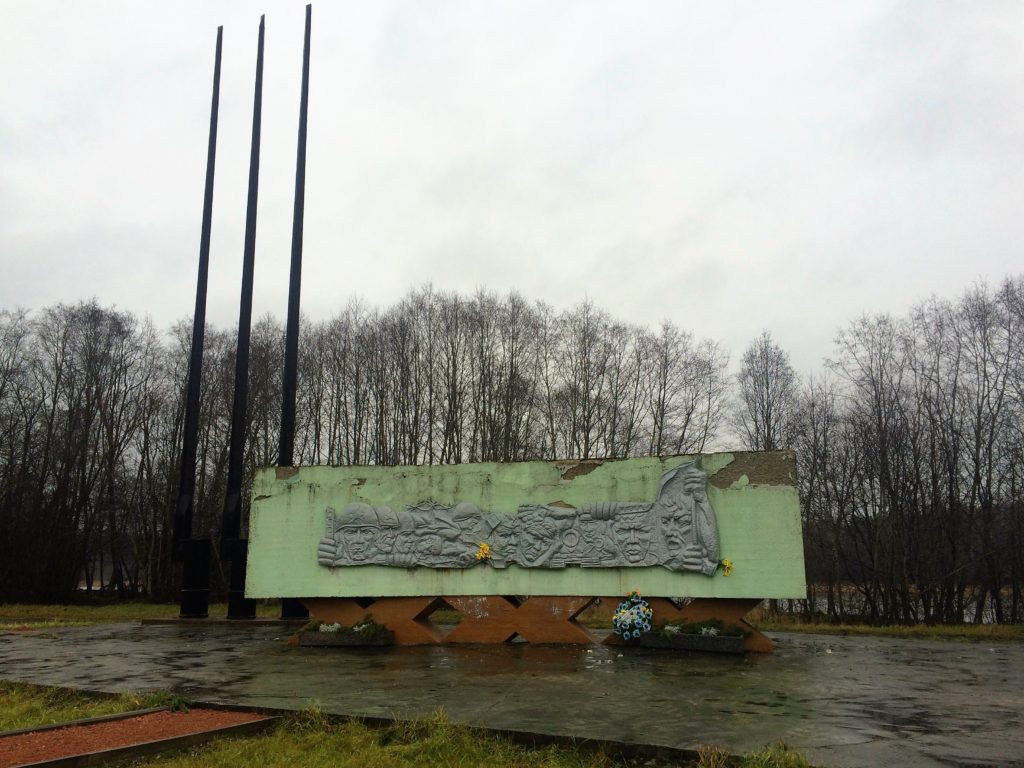
Further along the tributary, Estonia’s complicated history unraveled in the form of ever more conflicting memorials: a formation of three giant bronze bayonets erected in 1974 on the 30th anniversary of the Soviet liberation of Narva, a cemetery for Estonian soldiers killed during the war of independence (the crosses of the graves crudely ripped off their foundations by Soviet soldiers), and a crowded burial ground for 4,000 German soldiers who perished fighting the Soviets.
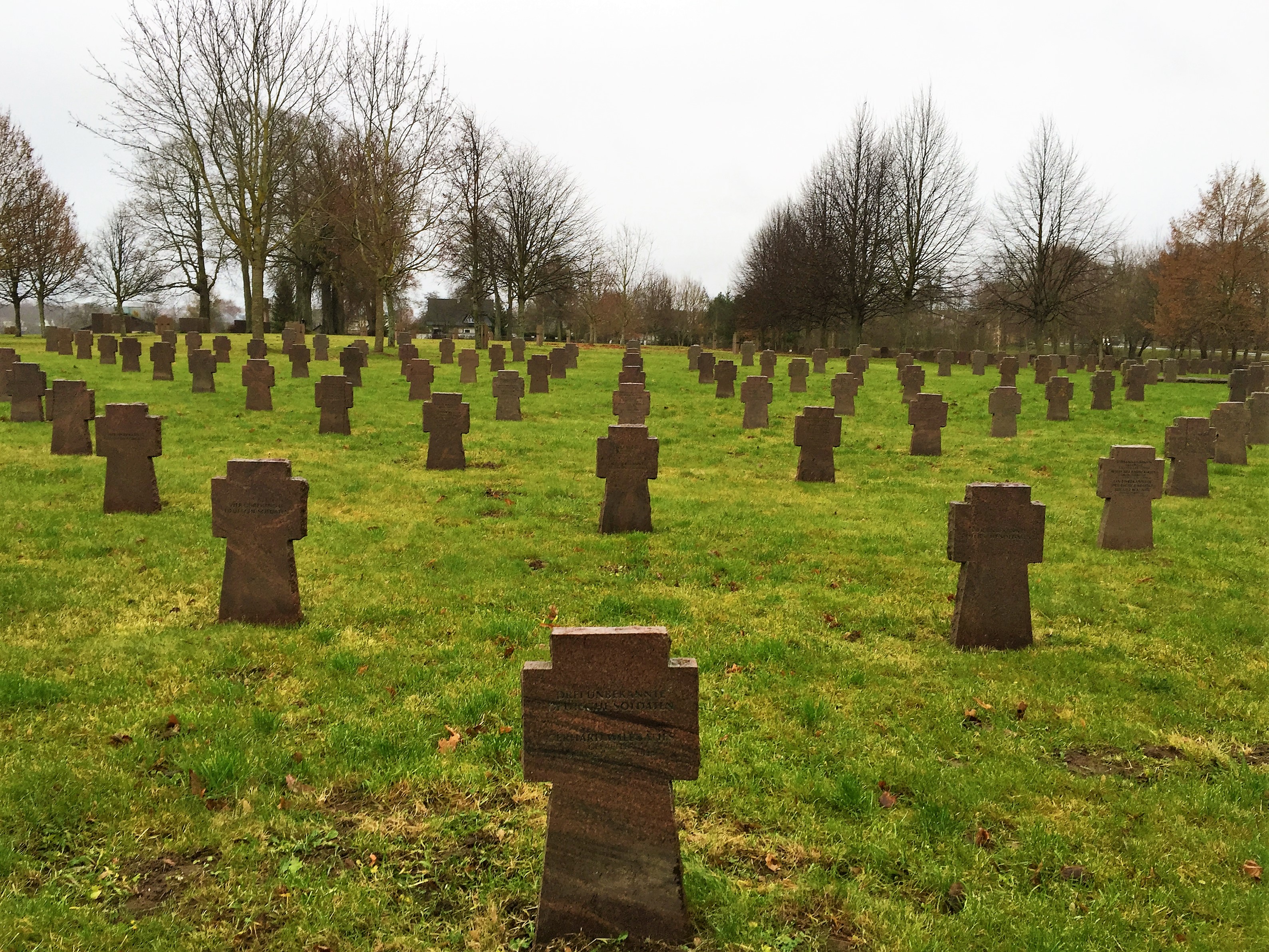
Having already reconnoitered Soviet missile silos in Latvia and Estonia’s southwest, our trip through the northern portions of country would not have been complete without visiting a vestige of the threat of nuclear apocalypse. Thankfully, the countryside outside Narva proved no exception.
Although the Cold War arms race required the United States and Soviet Union to marshal significant manpower and traditional resources, it also demanded the new currency of the atomic age: uranium. A small town a half hour west of Narva just happened to sit atop a large repository of uranium and other rare earth minerals. With a newfound demand for the radioactive rock, Sillamäe’s oil shale extraction facilities were retooled to unearth and enrich uranium. All told, 98,681 metric tons of uranium and 1354.7 metric ton of enriched uranium for military and civilian application were extracted and refined at Sillamäe’s metallurgical complex between 1950 and 1989. In recognition of its contribution to national security, Soviet authorities deemed Sillamäe a “closed city,” severely controlling access to the town and removing its location from civilian maps.
Unlike Narva, Sillamäe is a well-preserved and oddly charming example of early Soviet neoclassical architecture. The town is checkered with meticulously planned open boulevards flanked by stately buildings that wouldn’t seem out of place in St. Petersburg. At closer glance, the defining features of Stalinist architecture came into view: the Greek-style pediments and Doric columns sharing space with ornamental hammers and sickles and allegorical frieze lauding the achievements of homo sovieticus.
In the town center, a sinewy bronze figure held aloft a representation of the atom like Atlas. Like most sculptures of the Soviet era, the statue depicts one of the advances of the socialist people, in this case the harnessing of the atom and progression into the nuclear age. But reality was slightly different: Operations at Sillamäe’s uranium complex resulted in a 12-million-gallon open air repository of radioactive sludge, which caused enough alarm for the International Atomic Energy Agency to declare it a significant environmental risk in 1993.
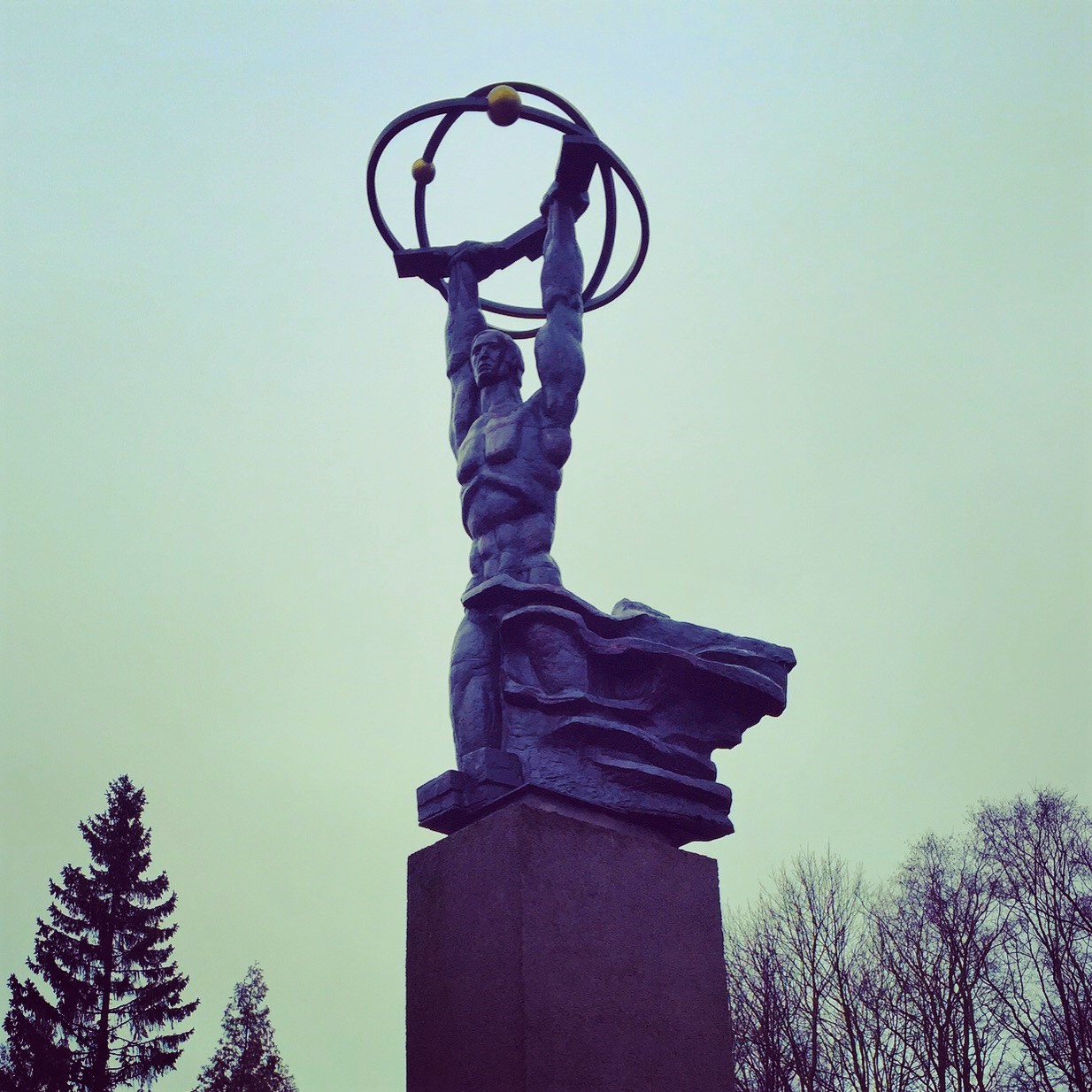
Today, Sillamäe stands Janus-like: Its Soviet-era buildings remain nearly as pristine as they were under the red banner. The uranium mine and processing facilities ceased operation in 1990, and the sludge dump is gone. An American company purchased the land in 2011 and extracts rare earths for consumer electronic goods, only one of two such mines in Europe. It seemed the farther west we traveled in Estonia, the more Soviet and Slavic influence yielded grudgingly to Europe. But even in Tallinn, the cosmopolitan and technology-oriented capital, the communist past could still be seen, if perhaps partially hidden from public view. We drove on, intent on re-discovering these neglected ruins.
Old Tallinn, a bustling port city once serving as the economic heart of the 14th Century mercantile alliance called the Hanseatic League, continues to thrive as a UNESCO World Heritage site and popular summer cruise destination. The frigid December weather deterred all but a small handful of tourists, allowing us to experience the town uninhibited by throngs of tour groups and vendors hawking cheap souvenirs. We walked through the charming cobblestone roads with medieval and Northern Renaissance guild halls and mansions of the wealthy German merchant class built between the 13th and 16th centuries. Their original owners long gone, most of these buildings now house foreign delegations fortunate enough to be posted in such grand accommodations. Old Tallinn’s architectural beauty was certainly a sight to behold, but we preferred to follow the path of precast Soviet concrete and made a beeline for an overlooked site at the city’s edge.
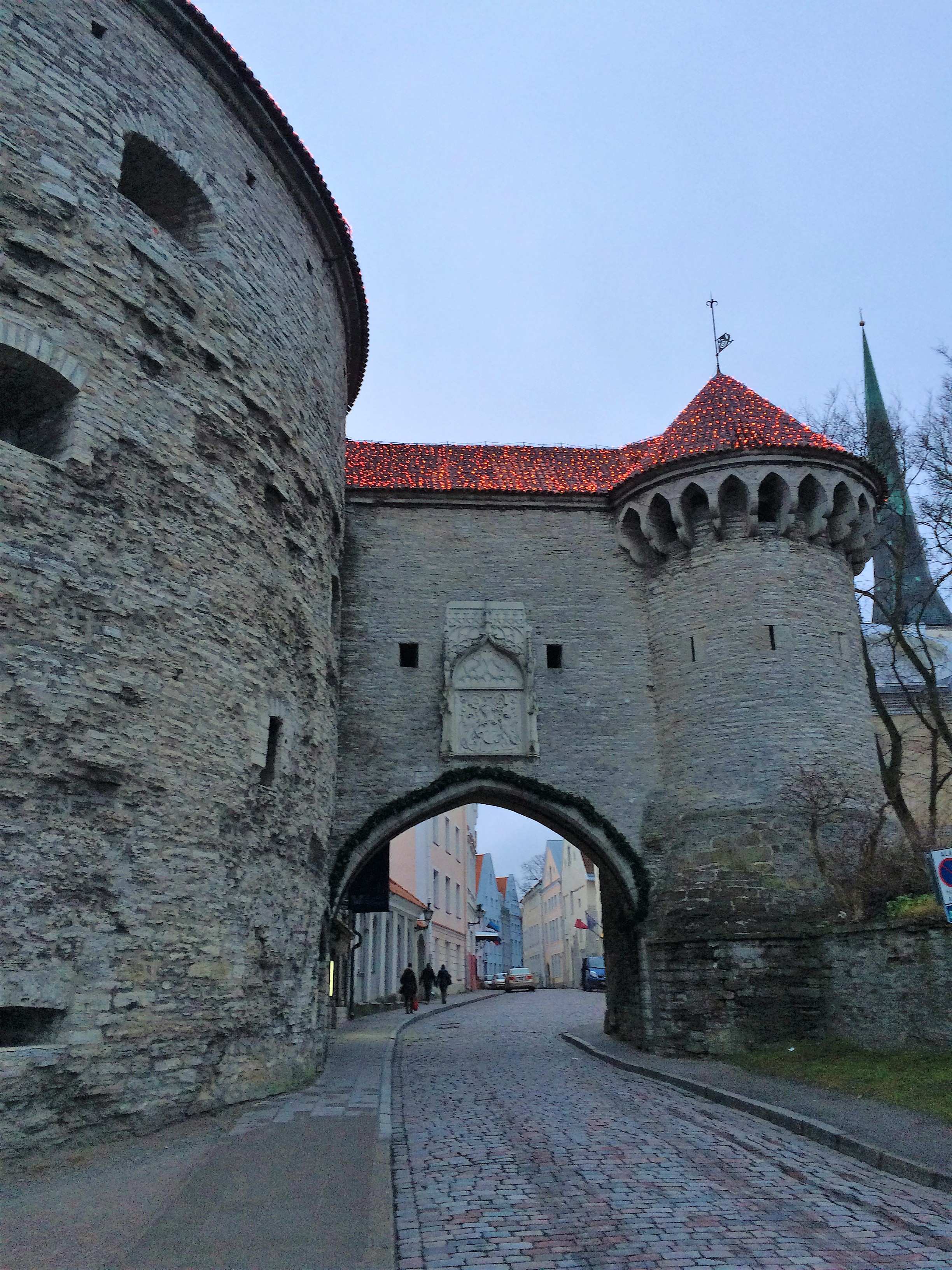
Cruising a few kilometers northbound from Old Tallinn down a picturesque coastal road led us through the steel gate of the unopened Estonian History Museum in search of what lies behind. Dozens of dilapidated statues and reliefs were left there, having been stripped from their foundations around Estonia. A head of Lenin appeared to sprout from the earth beneath us.
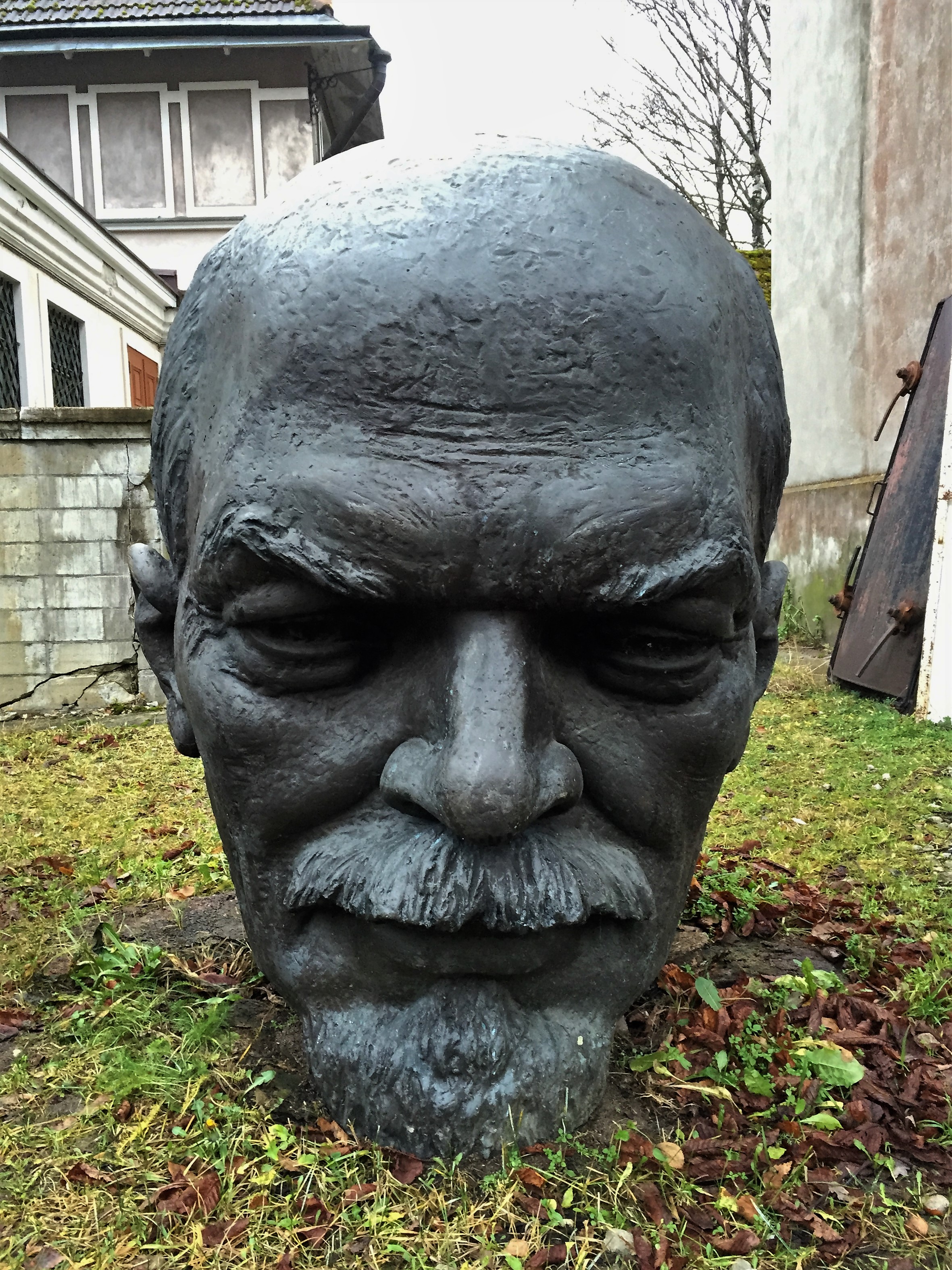
Intentional or not, the message this field of abandoned monuments conveyed was clear: Estonia’s Soviet past was anachronistic, and remnants of it were meant to be discarded rather than venerated. But the politics of national memory are never that simple, as Estonia learned in 2007. Departing the statue graveyard, we stepped over the figure of a strapping Soviet soldier cleanly sliced in half. Its upper half humbly reduced to ground level bore striking resemblance to the famous statue known as “Alyosha,” the center of attention during Estonia’s controversial “Bronze Night” riots in 2007 following its removal from a prominent location in Tallinn’s city center.
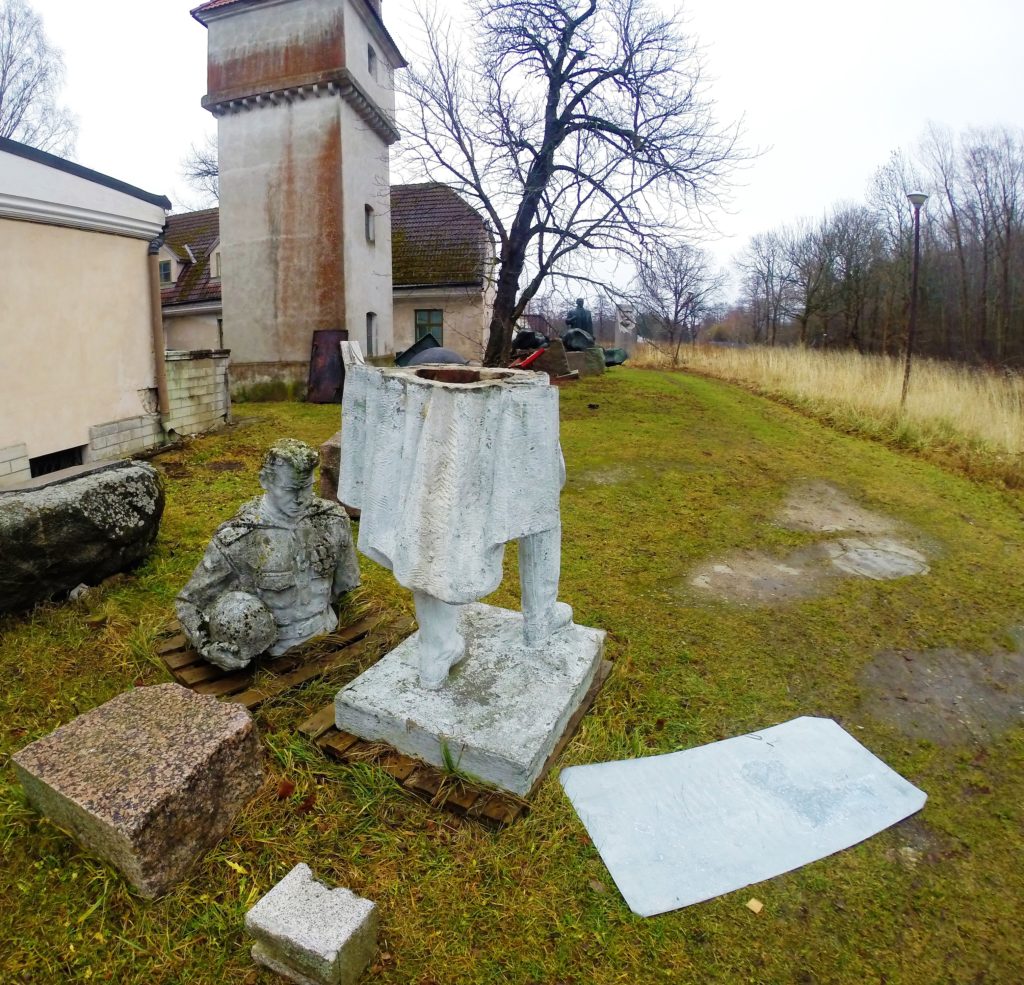
Only several hours after Alyosha’s removal, Estonian government websites began to experience outages. Before long, Estonian banks also began to experience similar issues with network activity that disrupted financial transactions and rendered many debits cards unusable. On May 9th, 2007 (Russia’s National Victory Day), the attacks reached their crescendo as 4 million packets of information bombarded hundreds of Estonian websites (including those belonging to schools and newspapers) every second. In a drastic attempt to thwart additional attacks, the Estonian government shut down all international web traffic into the country. What began as protests against the removal of a monument had escalated into one of the largest cyberattacks in history. Though it thoroughly denied involvement in the attacks, the Russian government was blamed for either coordinating the attack or at least encouraging pro-Russian surrogates.
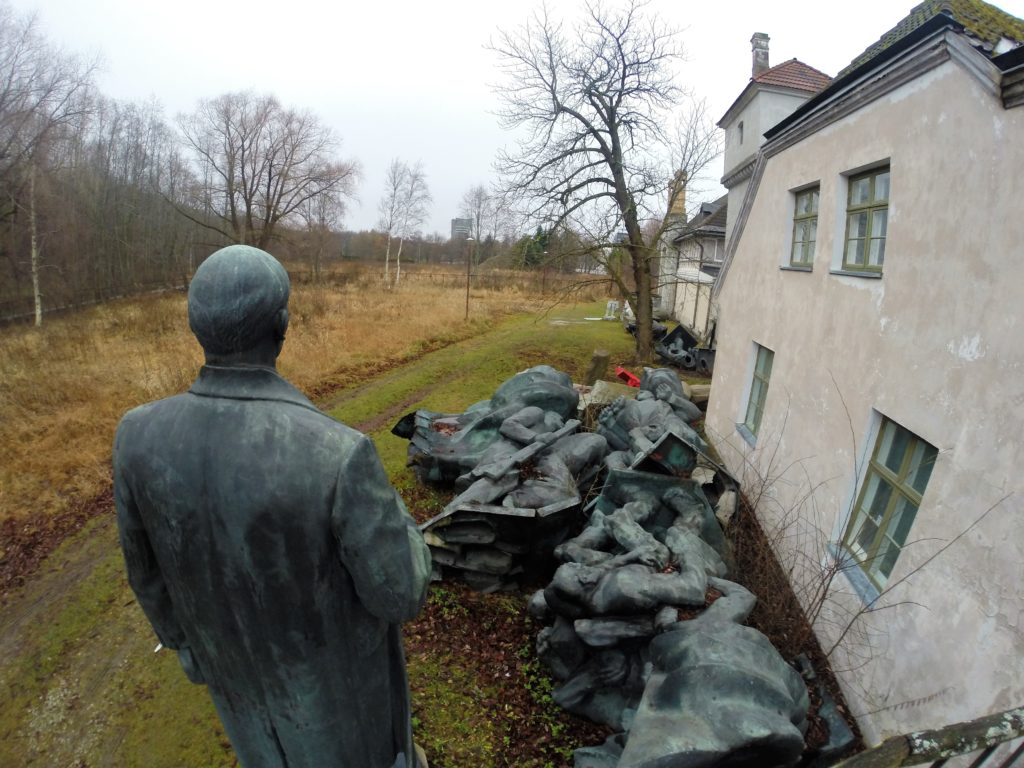
Estonia’s initiative to rid itself of Soviet symbolism and commemoration of the Red Army could only do so much. Leaving the statue graveyard, a gigantic symmetrical concrete structure caught our eye only a few hundred meters down the road. At first glance, we were certain that it was unmistakably left over from the Soviet period. We pulled the car off to the side of the road to investigate. Passing women pushing strollers and a few locals running with dogs, a complex of symmetrical concrete avenues crisscrossed a hill altered to match the smooth lines of the memorial itself. Rising from the rigidly shaped landscape, crumbling stone bleachers that once teemed with legions of neckerchief-clad Young Pioneers now sit idle and forlorn.
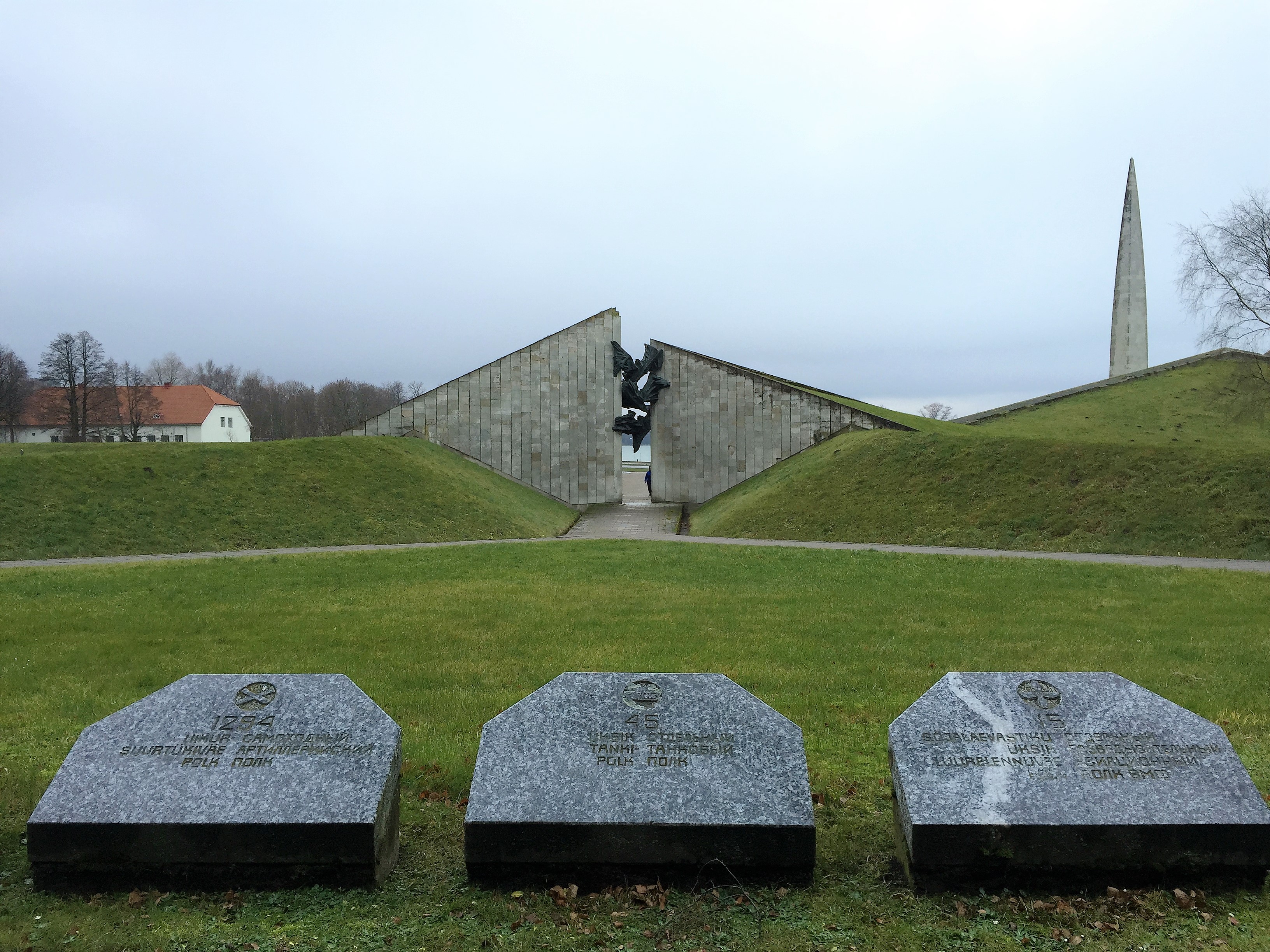
An obelisk looking like a concrete rocket rose from behind one row of bleachers, the monument erected to the dead of the Great War (ironically, in memory of Russian soldiers fighting against Estonians fighting to retain independence). Following one of the avenues away from the plaza, we were funneled through a chasm between the concrete walls, a bronze tangle meant to represent a flock of birds crowning the portal. On the other side, small memorial markers to Red Army units that fought in Estonia were arranged in an orderly row. And just off to the side, the dark grey crosses of the German War Cemetery were barely visible. Over 2,300 Wehrmacht and SS soldiers were interred here, though their eternal slumber was undoubtedly disturbed by Soviet bulldozers that landscaped part of the cemetery to make room for the brutalist complex of memorials.
Fortunately, a unique Soviet cemetery remained undisturbed in the forest despite being adjacent to a NATO airbase in the little-known village of Amari. Formerly a Soviet naval aviation facility, Amari Air Base was home to a detachment of Sukhoi Su-24 attack aircraft.
Today, Amari is one of two Baltic state air bases that hosts NATO’s Enhanced Air Policing Mission, charged with enforcing the territorial integrity of NATO states along its eastern flank. Member nations provide year-round rotational flights of interceptor aircraft, to respond to Russian incursions year.
Far from the small Soviet airstrip of the Cold War, Amari has become a significant hub for military aviation, with generous funding from both NATO and the United States. Driving along the perimeter fencing, we observed twelve U.S. A-10 Warthogs in an orderly row alongside the flight line. Deployed for a training rotation with Baltic allies, the tank-busters also served to send a message to neighboring Russia: Aggression in the Baltic States will be met in kind.
After driving along the forested periphery of the air base without finding Soviet graves, we finally asked for directions at one of the checkpoints. A somewhat bemused pair of Estonian soldiers offered to show us the way, beckoning us to follow their olive drab jeep down an unassuming dirt track. The jeep threw its hazard lights on, and the soldier in the passenger seat waved his army towards the woods indicating our destination was near.
Several ranks of tailfins formed a somber formation in the damp woods. The gunmetal grey tails of Soviet fighter aircraft had lost their chrome metallic sheen, but the prominent red stars emblazoned on the sides surprisingly retained their ruddy hue even as they were being slowly enveloped by green moss. Today, they serve as gravestones for the Soviet pilots who lost their lives in crashes during the Cold War. Some tails bore small black-and-white photos of the deceased, the stern gazes of Russian pilots staring back at us as we explored the gravesites. Others had more traditional Russian headstones in front of the tail sections, with etched images of Su-24s adorning the granite surfaces.
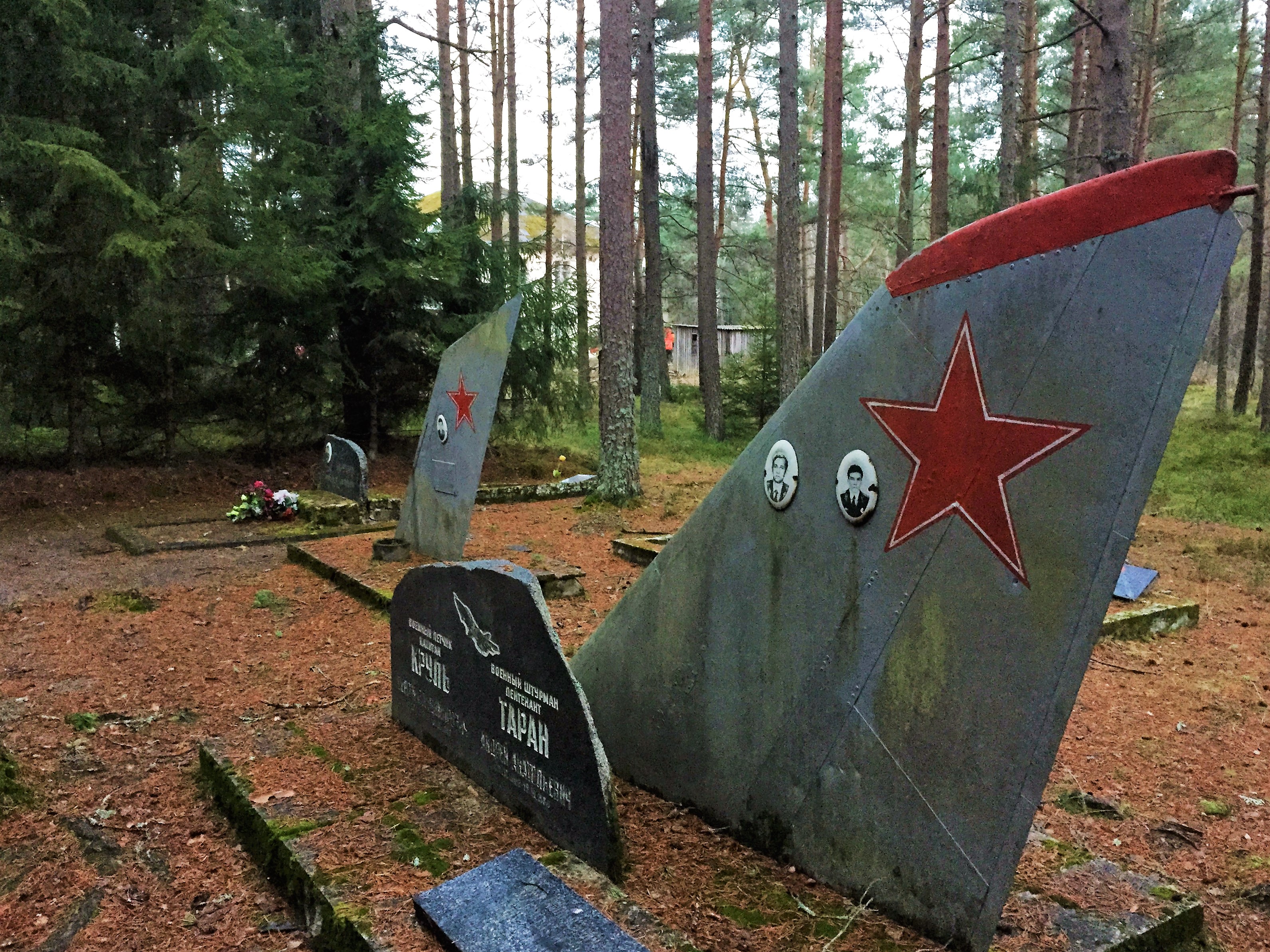
Standing beside the lonely graves, it was hard to imagine what these pilots would have thought of their base now serving as host to NATO fighters, intercepting young Russian pilots not unlike themselves. Perhaps some would have appreciated their storied aircraft, still serving Russian forces and conducting dangerously low-level overflights of U.S. naval vessels in the Baltic Sea.
The winter sun dipped below the horizon, marking the last full day of our adventures.
Despite the decrepit nature of many of the abandoned sites we visited, they still evoke memories charged with meaning today. For those who embrace the idea of Novorossiya, they conjure up a sense of Slavic triumphalism from when Russia and Eastern Europe stood shoulder to shoulder as a world power that felled Nazi Germany. These monuments continue to reinforce a collective memory of strength and exceptionalism for many ethnic Russians living in enclaves across the former Soviet Union.
But for many Estonians, Latvians, and Lithuanians, the Soviet past represents a time of oppression, deportations, and methodical obliteration of Baltic nationalism and culture. These opposing memories continue to be resurrected in international news headlines: NATO bolstering combat power in seemingly vulnerable Baltic States, Latvia calling for an increase in defense spending and troop numbers, and Estonia fearing a Crimea-like takeover in ethnic Russian enclaves such as Narva.
Writing for Foreign Affairs in 1951, George Kennan remarked that “…the Baltic countries should never again be forced against the innermost feelings of their peoples into any relationship whatsoever with a Russian state…” Yet Kennan also contended that the Baltic nations “…would themselves be foolish to reject close and cooperative arrangements with a tolerant, non-imperialistic Russia, which genuinely wished to overcome the unhappy memories of the past and to place her relations to the Baltic peoples on a basis of real respect and disinterestedness.” Regrettably, the tolerant and non-imperialist Russia Kennan hoped for has failed to materialize. We left the Baltic states with the unsettling thought that we might be sent back one day, but in uniform, to roll back Russian aggression.
Far from being confined to the Baltic nations we visited, hundreds of vestiges of the Cold War remain dotted across Eastern Europe, many rotting away in obscurity while others become friction points of the new fault line between NATO Europe and the Russian Federation. As our Baltic exploration finally came to a close, we boarded our flight with a newfound appreciation for the lingering impact of the Cold War on current European and Russian relations. Our desire to learn from Eastern Europe’s forgotten monuments only increased, leading us to into the Balkans still haunted by the ghosts of soviets past.
Adam Maisel is a Military Intelligence Officer in the Army Reserve and veteran of Operations Enduring Freedom and Freedom’s Sentinel. Adam also serves as a civilian military intelligence adviser to US, NATO and allied forces. The opinions expressed are his and his alone.
Will DuVal is a recent graduate of Santa Clara University and an Army Reserve Military Intelligence Officer. Will has worked with the Truman National Security Project, U.S. Mission to NATO, and Office of the Assistant Secretary of Defense for Public Affairs. The views and opinions expressed in this article are his and his alone.
If you are interested in using these photos, please contact War on the Rocks to inquire.

